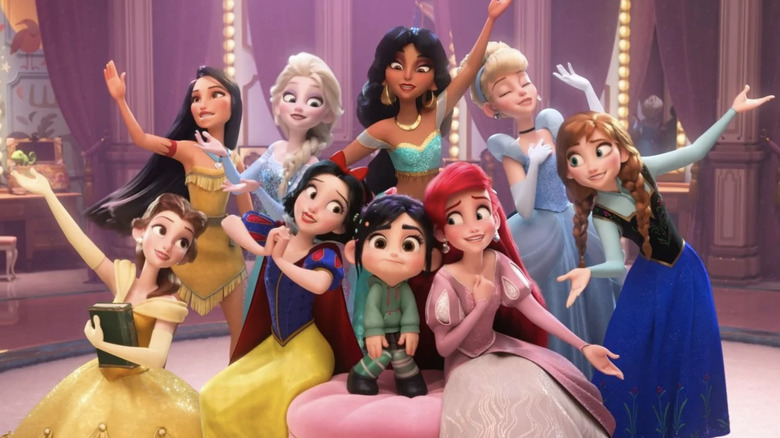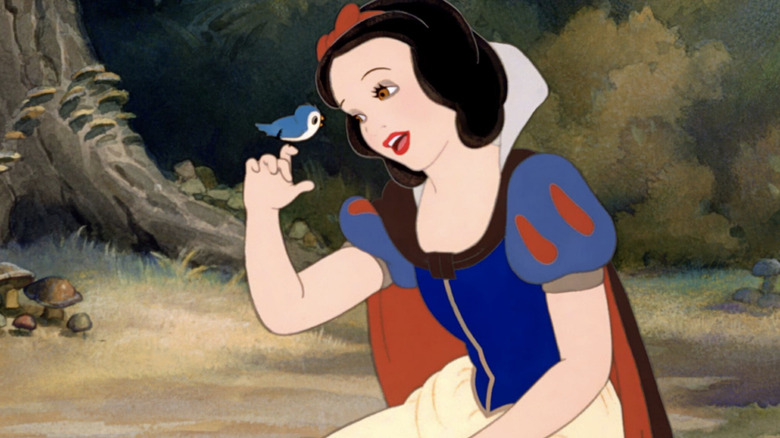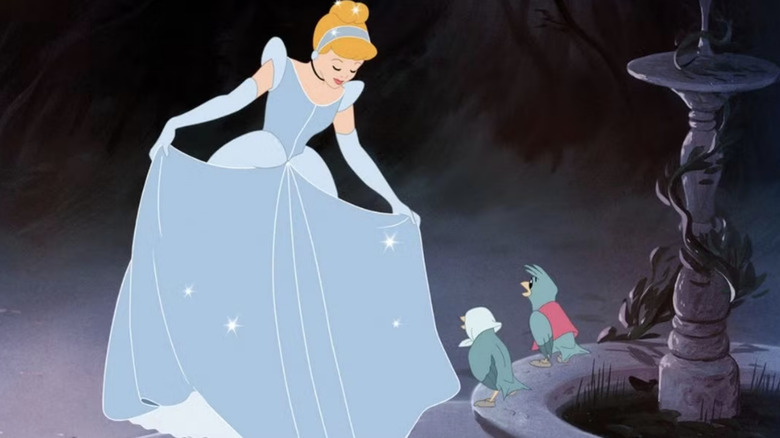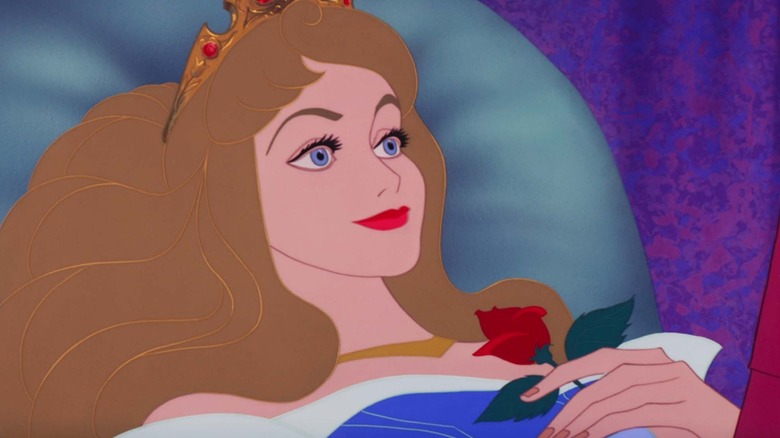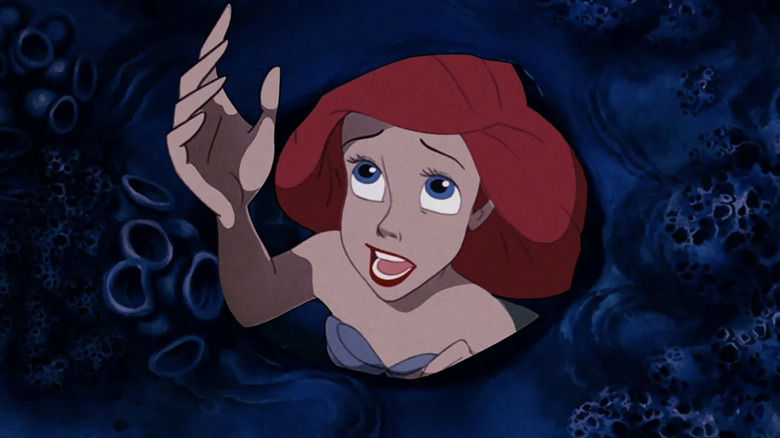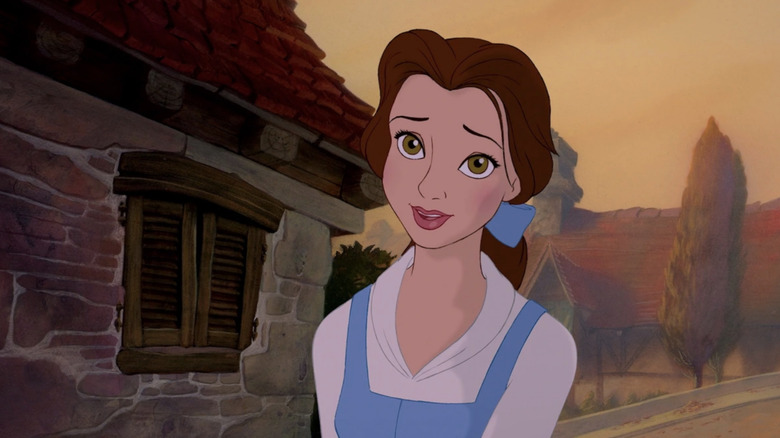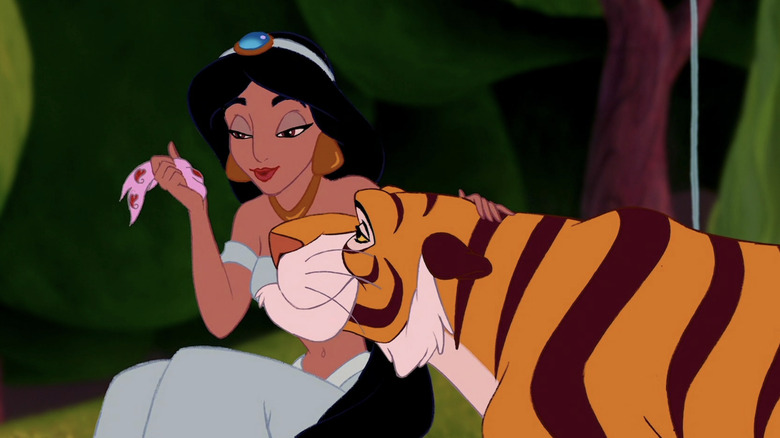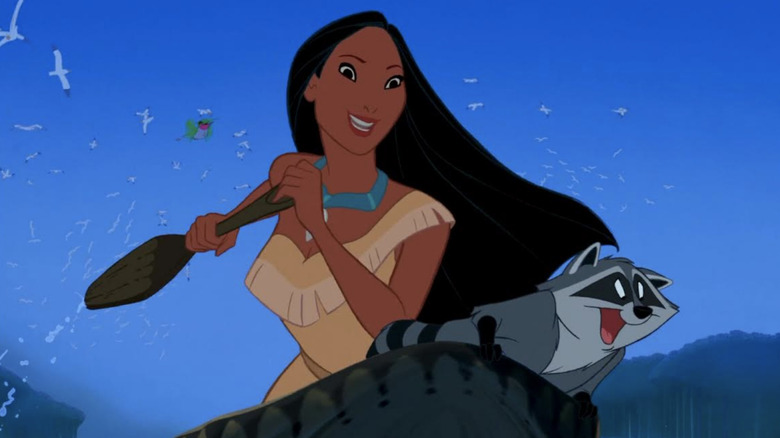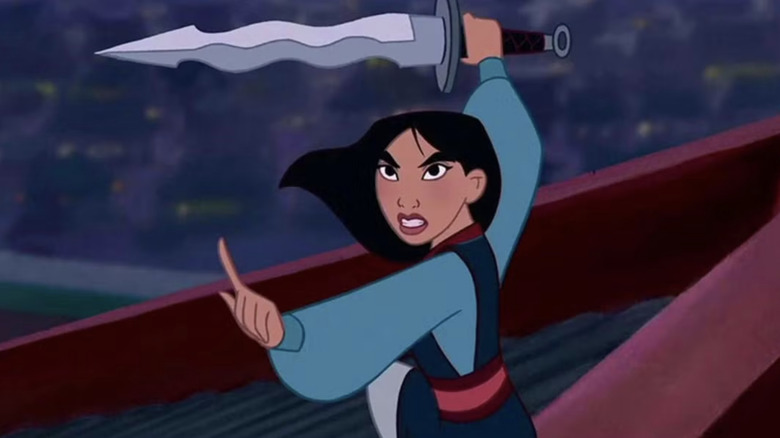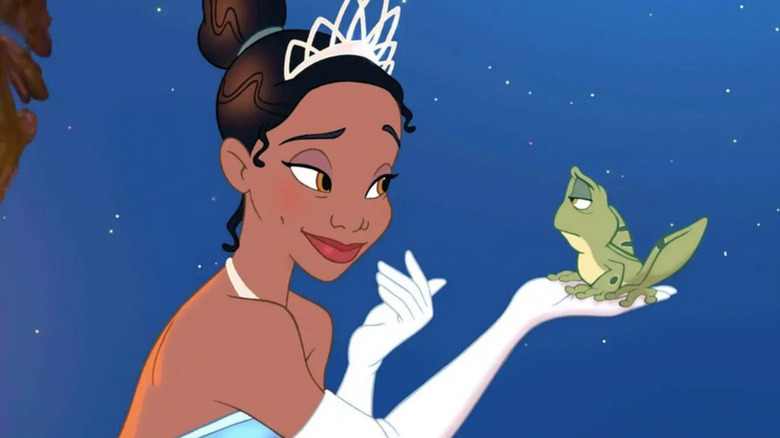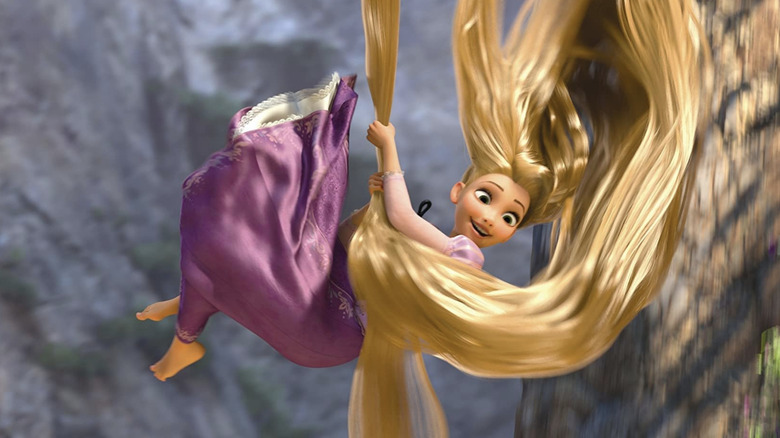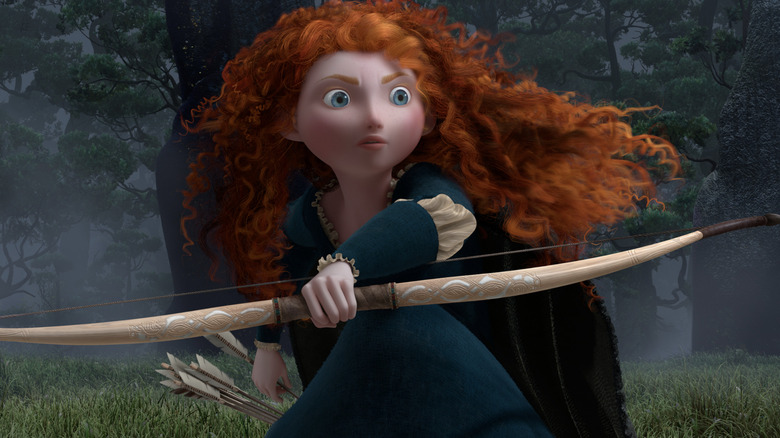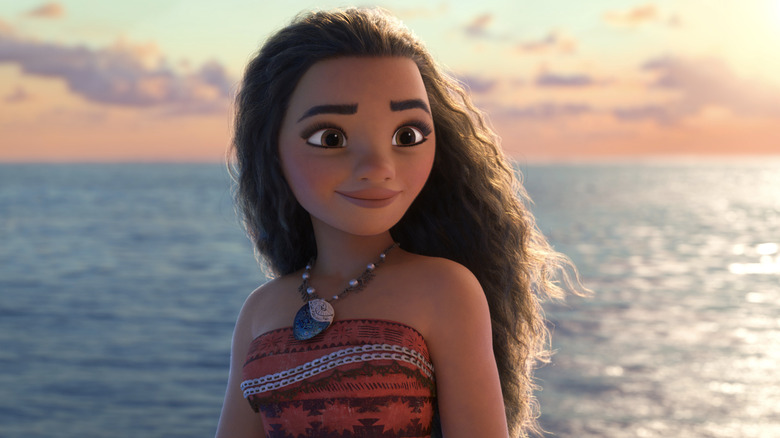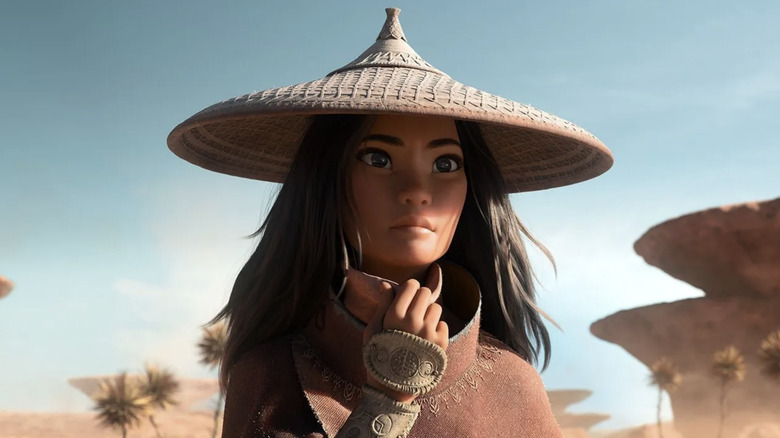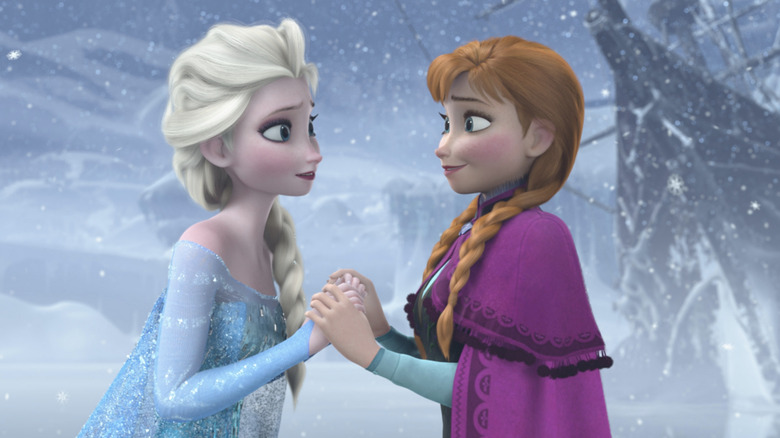The Official Disney Princess List In Order: How Many Are There?
There's no princess quite like a Disney Princess. While some might argue that characters like Princess Leia from "Star Wars" or even jokingly suggest that the Xenomorph Queen from "Aliens" ought to qualify, the truth is that not every princess that Disney has put on the screen is actually considered a Disney Princess. When the Disney Princess brand officially launched in 2001 (something only adult Disney Princess fans would notice), just nine Princesses were included on the roster. Since then, some members of the original lineup were dropped (sorry Tinker Bell and Esmeralda), with new princesses added to the list, which now sits firmly with 13 in total. But could more be added soon? Anything's possible, especially as Disney continues to craft new fantastical adventures for young girls.
From the moment the Disney Princess brand was launched, it grew quickly. The New York Times even called it the "fastest-growing brand the company has ever created," which is no small feat. But this begs the question, who is actually considered an official Disney Princess? Well, aside from the obvious classics, there are some you likely won't guess. On the other hand, there are omissions that might seem a bit confusing, making one wonder why they didn't make the cut. As we dive into one of Disney's oldest franchises, let's celebrate the wonderful history of the studio's most notable princesses. Sure, there are a lot of creepy stories behind the Disney Princess movies, but that doesn't mean we can't still enjoy the "Disney-fied" material.
Snow White (1937)
The very first full-color animated feature film to hit theaters, as well as the first to graduate from stop-motion to cel animation, "Snow White and the Seven Dwarfs" was a game changer for Walt Disney. Not only was the film — released first in December 1937 — a major box-office success, but it also earned Disney an Honorary Oscar. Adriana Caselotti voiced Snow White, who set the stage for most of the Disney Princess tropes that the brand came to be known for. Even close to 90 years later, Disney's original princess remains an important figure within the brand.
Her innocent, kind, and trusting nature makes Snow White particularly virtuous, and her ability to talk to animals comes in quite handy. It's no wonder she was the first fictional female character to receive a star on the Hollywood Walk of Fame — and is still the only official Disney Princess to do so. Of course, the Disney version is a far cry from the original Brothers Grimm fairy tale, but that's sort of Disney's whole thing. Any way you look at it, the entire Disney Princess brand would fall apart without Snow White.
Cinderella (1950)
Considering how often Disney Princess films come out these days (or, at least how often they seem to), it feels strange that Walt Disney didn't make "Cinderella" for another 13 years after "Snow White and the Seven Dwarfs" was triumphantly released to theaters. But on the verge of bankruptcy following films like "Fantasia," "Bambie," and "Pinocchio," Disney eventually turned to adapt Charles Perrault's classic fairy tale. The results speak for themselves. "Cinderella" was a massive hit, and the film saved the company in one of its darkest hours. Few Disney Princesses can claim that.
As for the princess herself, Cinderella (voiced originally by Ilene Woods) marries into her royal title, but she certainly deserves it. Her hopeful and optimistic outlook on life in spite of her dire circumstances, kindness toward small creatures, and down-to-earth attitude makes her one of Disney's most wonderful princesses. There's a reason this story has been retold again and again over the years — it's just magical.
Aurora (1959)
Only nine years after "Cinderella" was released, Walt Disney brought "Sleeping Beauty" to theaters. The film introduced audiences to the lovable Briar Rose, whose real name in the Disney canon is now Aurora (Mary Costa). Though Disney had actually began working on "Sleeping Beauty" back in 1950, it took nearly a decade for the final product to be released. Completing the trinity of the original Disney Princesses, Aurora was the last official princess for a long time as "Sleeping Beauty" was a box-office failure – which is really a shame.
Playful, imaginative, and romantic, Aurora has one of the most iconic looks in the Disney Princess canon, even if it's not exactly accurate to the original film. In the movie, Aurora dons the blue dress her fairies make for her — it's only at the very end that the dress is magically turned pink. Nevertheless, to separate her from Cinderella, who also has blonde hair and a blue dress, most official Disney promotional materials featuring Aurora show her in the dress's alternate pink color.
Ariel (1989)
It was 30 years before the Walt Disney Company (sans its founder, who died in 1966) pursued another Disney Princess. In fact, the House of Mouse opted not to adapt any new fairy tales at all after "Sleeping Beauty." Though movies like "The Black Cauldron," which feature plenty of fantasy elements, were greenlit, traditional Disney Princesses were ignored. That is, until Disney found courage to try again in 1989 with "The Little Mermaid," which not only revived Disney's interest in fairy tales, but also began what's come to be known as the Disney Renaissance. Though it's nothing like the original "Little Mermaid" story, Ariel's introduction won over a new generation of audiences.
As for the mermaid herself, Ariel's hopeful, tenacious, and rebellious personality made her instantly likable. Even if some have criticized the notion that she would give up her voice for love (and legs), she's still one of the most popular princesses that Disney ever put on screen. Mixed with the powerful vocals of Jodi Benson, Ariel was the first Disney Princess to spark her own animated series, which ran for three seasons on CBS.
Belle (1991)
Two years after "The Little Mermaid," Disney released "Beauty and the Beast" to widespread critical and commercial acclaim. It was the first Disney animated flick to be adapted as a stage musical (which hit Broadway in 1994), no doubt because of the princess involved. Renamed simply "Belle" from Jeanne-Marie Leprince de Beaumont's original fairy tale (where she was called "Beauty"), the Paige O'Hara-voiced character warmed hearts almost instantly. Like Cinderella, she marries into royalty, but appears quite regal in the way she holds herself even before receiving a crown.
A bookworm with a penchant for learning and a wanderlust for adventure, Belle receives the thrill of a lifetime when she's forced to remain at the Beast's (Robby Benson) castle. While it's sad at first, she slowly comes to care for the creature, discovering his softer side and the fact that he is living under a mysterious curse. Sure, some have cried "Stockholm syndrome" ever since, but can we blame the girl? The guy gave her his entire library! No book lover would say no to that.
Jasmine (1992)
Jasmine (played by Linda Larkin) is by far one of the most unique princesses on the roster. Not only is she the first non-European princess of the bunch, but she is the only Disney Princess not to be the lead in her own movie. Debuting just after Belle the previous year, Jasmine first showed up in 1992's "Aladdin" as a princess of marriagable age in the city of Agrabah, though she vows not to marry a man she doesn't love. It's then that Aladdin (Scott Weinger) comes along, and quite literally sweeps her off her feet.
But Jasmine's distinct agency, independent convictions, and heroism in the face of danger mark her as different from many of Disney's more classical princesses. Certainly more in step with Belle and Ariel, Jasmine has made a name for herself beyond her initial appearance. She returned in various direct-to-video features and the three-season "Aladdin" animated series that ran in the mid-'90s. Although she's never gotten a movie of her own, she remains a firm member of the Disney Princess collective.
Pocahontas (1995)
In the mid-'90s, Disney decided to it was time to move on from fairy tales and adapt a historical princess. Pulling from American history rather than the Old World this time around, "Pocahontas" arrived in theaters in 1995, billed as a romantic retelling of the titular Powhatan woman's history. In particular, the film explored her coming-of-age story, as well as her romance with John Smith (Mel Gibson). Like many of the other Disney Renaissance-era princesses, Pocahontas (voiced by Irene Bedard) is fiercely independent, courageous, and holds fast to her convictions, even if it means separating herself from her people.
Though "Pocahontas" is far from an authentic retelling of the historical record — indeed, the real Pocahontas wasn't even technically a princess, though she was the daughter of a chief — it's a thrilling adventure that introduced us to the very first American Disney Princess. In fact, some say that the success of "Pocahontas" is what pushed the studio to further explore films about Disney's strong, independent female characters, such as "Mulan," Brave," and "Frozen."
Mulan (1998)
Continuing to distance themselves from fairy tales, Disney instead decided to adapt the Chinese legend of Hua Mulan in 1998. Following Pocahontas' lead, Mulan (voiced by Ming-Na Wen) proved herself a skilled and smart protagonist, one who was a bit more adventurous than some of the original Disney Princesses. But if you're wondering how Mulan could be considered a Disney Princess at all, note that she's the one exception to the royalty rule. While all Disney Princesses must either be royalty by blood or marriage, Mulan is made Disney royalty by honor.
Ever since the brand was launched, Mulan — the only member of East Asian descent — has always been there, and she's more than earned it. "Mulan" itself is an exceptional film that's widely beloved, and for good reason. Mulan's courage, honor, and intelligence make her one of the most well-rounded of any of her contemporaries. The farthest thing from a damsel in distress, Mulan proved herself worthy of her Disney Princess title when she brought honor to not only her family, but all of China.
Tiana (2009)
In our world of modern computer-generated animation, it's rare that 2D features are made anymore. That's even true these days of the Disney Princess line. But the last princess in the House of Mouse's catalog to be traditionally animated in her initial appearance was Tiana (Anika Noni Rose), the protagonist of 2009's "The Princess and the Frog." Inspired by the Brothers Grimm's "The Frog Prince" fairy tale, this Disney feature reinterpreted the material in a 1920s New Orleans setting, giving the film a soulful and distinctly American feel.
As for Tiana herself, she's a hard-working go-getter who fights to obtain her dreams. But unlike many of her fellow Disney Princesses, Tiana has a very specific character arc. Throughout the film, she learns that a full life means more than just working toward her dreams all the time. It also means having fun, enjoying her friends, and even falling in love. That's where Prince Naveen (Bruno Campos), our resident frog prince, comes in. As one of the most developed princesses on this list, Tiana is a fine addition who continues to delight with every "Princess and the Frog" rewatch. Give this girl a sequel!
Rapunzel (2010)
With "Tangled," Disney opted to both return to a more traditionally-inspired sort of Disney Princess tale while also ushering the company into animation's computer-generated future. Based on the Brothers Grimm tale "Rapunzel," this 2010 adventure features Mandy Moore as the curious, upbeat, and adventurous Rapunzel, who is perhaps the most delightful of the bunch. Her debut marked not only the end of traditional animation in the Disney Princess saga, but arguably the last Disney Princess film that echoed earlier pictures such as "Sleeping Beauty," "The Little Mermaid," and "Beauty and the Beast."
Rapunzel is adorable, and her journey toward discovering the world feels right out of a storybook. More than that, her coming to terms with the fact that Mother Gothel (Donna Murphy) actually kidnapped her was a smart move on Disney's part, making her story more than just "the prince saves her from the tower." Though "Tangled" never spawned a sequel film, Rapunzel and Eugene "Flynn Rider" Fitzherbert (Zachary Levi) cameo in "Frozen" only a few years later, and even received a short film coda and a multi-season animated series continuation.
Merida (2012)
There are a lot of firsts when it comes to the Disney Princesses of the 21st century, and Merida (Kelly Macdonald) certainly continued that trend. Not only is Merida the first Disney Princess to hail from a Pixar film (in this case, 2012's "Brave"), but she's also the first to remain single from the beginning of the film to the end. While all those who preceded her ended up married, engaged, or otherwise betrothed by the end credits, Merida's journey is all about saving her family from a wish she accidentally inflicts upon them.
Set in medieval Scotland, "Brave" is fairly underrated. The whole film is centered on Merida's relationship with her mother, Queen Elinor (Emma Thompson), which is particularly rocky after she proves just how much she doesn't want to be married off. Although it's a reversal on the original Disney Princess formula, "Brave" feels very traditional in its character designs and fairy tale structure, despite being the first Disney Princess feature not based on a pre-existing story, legend, or historical event. We told you, lots of firsts.
Moana (2016)
Five years after "Brave," Disney got back to work at bringing another non-traditional princess to the screen. With 2018's "Moana," the House of Mouse sailed to ancient Polynesia to introduce our new titular heroine (voiced by Auliʻi Cravalho). Inspired by Polynesian mythology (hence the inclusion of Dwayne Johnson's Maui), the tale begins with Moana's dream to set sail and begin her own hero's journey. And while she does that, she finds herself on quite the adventure.
Moana's bravery, determination, and strong will are some of her greatest assets, and though she needs Maui's help to save her people, she presses on even when he fails her. Whereas most Disney Princesses received either short film follow-ups, animated series continuations, or direct-to-video sequels, Moana is the only one currently on the official roster to receive a theatrically released sequel, "Moana 2." Maybe this will mark a new wave of Disney Princess sequels rather than another batch of live-action remakes.
Raya (2021)
The most recent addition to the Disney Princess legacy, Raya (Kelly Marie Tran) was first introduced in the 2021 feature, "Raya and the Last Dragon." Hailing from the Southeast Asia-inspired Humandra, Raya is a warrior first and a princess second, fueled by a deep need for redemption after accidentally causing her father to be turned to stone. Hoping to find the last dragon, Sisu (Awkwafina), and convince her to help defeat the mindless Drunn, Raya embarks on a high-fantasy adventure that rivals both "Mulan" and "Brave," forging her own path in the process.
But Raya's placement among all the other Disney Princesses is admittedly a bit confusing. While she is a princess in a movie made by Disney (which doesn't necessarily make one a Disney Princess, mind you), "Raya and the Last Dragon" is more of an action-adventure fantasy film rather than the usual Disney Princess musical. In fact, there are no songs in the film at all. Raya has no solo musical number, nor is the film structured like many of the previous pictures listed here. It's an odd choice, and one that has been confusing to many fans of the brand, but it's one Disney has stuck with since her arrival.
Wait, why aren't Anna and Elsa official Disney Princesses?
After all that, you're probably wondering why "Frozen" powerhouses Anna (Kristen Bell) and Elsa (Idina Menzel) weren't listed as official Disney Princesses. Well, simply put, because Disney doesn't consider them a part of the brand. The official Disney Princesses website lists only the above characters, despite these two sometimes being included with the Disney Princesses in official material. They even show up as a guests of the official Princesses in 2018's "Ralph Breaks the Internet." But why doesn't the House of Mouse include them on their official roster? Because they're the stars of their own franchise.
You'll notice that the other Disney Princesses don't headline their own highly acclaimed, multi-million dollar hit franchises. In fact, "Disney Princess: Beyond the Tiara" author Emily Zemler notes that, originally, the Disney Princess characters weren't even allowed to talk to each other, let alone interact. That would instantly disqualify "Frozen's" two sisters. But more likely, the decision to keep them separate is because the "Frozen" brand has proven so distinct and lucrative on its own. Unsurprisingly, Anna and Elsa aren't the only ones to get the shaft either.
We already mentioned that Tinker Bell and Esmeralda were once dropped from the official lineup (as was Jane Porter from "Tarzan"), but others such as Amy Adams' Giselle from "Enchanted" and Princess Elena (Aimee Carrero) from "Elena and the Secrets of Avalor" have never even been considered. Likewise, "Wish" lead Asha (Ariana DeBose), who was meant to be a tribute character to all eras of Disney, has been left out as well. Turns out, becoming a Disney Princess is even tougher than it looks.
